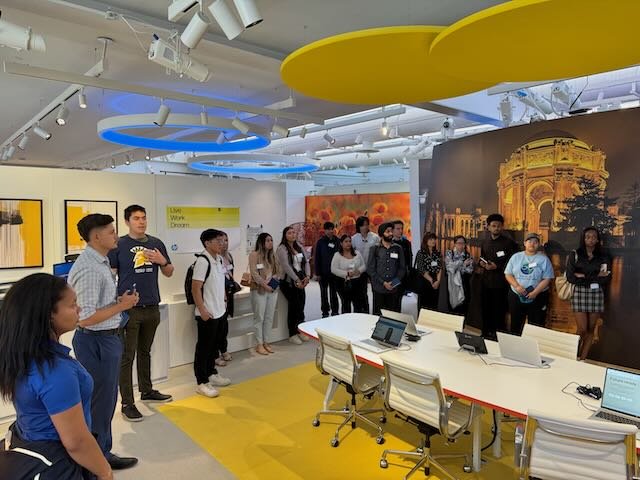CAREER EXPLORATION PARTNER
WORKSITE VISITS
Host students at your company for a tour, speaker session, and networking or mentoring opportunity. Worksite visits offer students the opportunity to observe daily operations and engage with employees about their educational and professional journeys. They bridge the gap between classroom learning and real-world application, help students understand potential career paths, and foster lasting relationships between employers and schools.
HOW IT WORKS
Employer
Provides students with a company tour, a speaker session, a networking or mentoring opportunity, and appropriate food and beverage.
We also ask that the host company bring employees to participate who share the backgrounds of the students.
Ideally, companies will engage their employee resource groups, and employers can leverage the SVLG ERG/BRG Consortium to help coordinate.
Resources
K-16 Collaborative
Recruits the students
The K-16 Collaborative can work with our extensive network of schools to supply a group of any size, from 5 to 500.
Our multilayered consortium allows us to do targeted recruiting based on employers’ outreach priorities: by school, program, demographics, etc.
Works with each educational institution to handle logistics.
Pays for students’ transportation.





RECOMMENDATIONS
To ensure that a student worksite tour, panel, and networking session become impactful and enduring interventions, especially for students from BIPOC (Black, Indigenous, and People of Color) communities, the Bay Area K-16 Collaborative recommends that teachers and employers implement the following strategies.
Preparation and Orientation:
Employers: Provide pre-event materials explaining the company culture, event agenda, and professional expectations. Highlight stories of BIPOC employees to create a relatable context.
Educators: Offer thorough preparation and orientation, familiarizing students with the worksite, panelists, and networking expectations. Provide guidance on professional etiquette, networking skills, and cultural nuances.
Meaningful Engagement Opportunities:
Employers: Create interactive elements like Q&A sessions, small group discussions, or hands-on activities to encourage participation and collaboration.
Educators: Prepare students with questions and topics for discussion during interactive sessions. Encourage active participation and collaboration during the event.
Mentorship and Support:
Employers: Pair students with mentors, ideally from ERGs, who can provide guidance and support during the event and beyond. Foster a supportive environment where students feel valued and empowered to ask questions.
Educators: Help students identify potential mentors and support systems within the event. Provide guidance on how to seek and maintain mentorship relationships.
Representation and Diversity:
Employers: Ensure that panelists, speakers, and hosts represent diverse backgrounds and experiences. Prioritize inclusivity and diversity in selecting speakers and panelists.
Educators: Encourage students to engage with diverse role models. Highlight the importance of representation and diversity in professional settings.
Empowerment and Advocacy:
Employers: Empower BIPOC students to advocate for themselves, ask questions, and assert their presence and perspectives. Encourage them to voice their opinions and share their experiences confidently.
Educators: Encourage students to advocate for themselves, ask questions, and assert their presence and perspectives. Support them in voicing their opinions and sharing their experiences confidently.
Follow-Up Opportunities and Resources:
Employers: To extend the event's impact and align it to your diversity recruiting goals, provide the students with internship/job application codes that will tag them for special review by your recruiters. More broadly, provide access to networking platforms or other professional development resources, and organize follow-up sessions to reinforce learning and support continued growth.
Educators: Assist students in accessing and utilizing provided networking and professional resources. Encourage reflection on the experience and goal-setting for future career aspirations.


